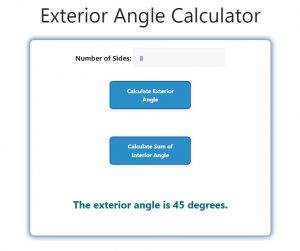About Exterior Angle Calculator (Formula)
Understanding the geometry of polygons can be simplified with tools like the Exterior Angle Calculator. Exterior angles are critical in various design, architectural, and mathematical applications. Whether you’re working with regular polygons or studying geometric principles, calculating exterior angles allows you to determine the space each angle occupies in a polygon.
Formula
The formula to calculate the exterior angle of a regular polygon is straightforward:
A = 360 / N
Where:
- A is the exterior angle.
- N is the number of sides of the polygon.
How to Use
Using the Exterior Angle Calculator is easy:
- Determine the number of sides (N) of the regular polygon.
- Input this number into the calculator.
- The calculator will apply the formula and give you the value of the exterior angle (A).
Example
Let’s take an octagon (8-sided polygon) as an example:
- N = 8
- Applying the formula: A = 360 / 8
- The exterior angle, A, is 45 degrees.

FAQs
- What is an exterior angle? An exterior angle is the angle formed between one side of a polygon and the extension of an adjacent side.
- What is the exterior angle of a triangle? For a triangle, the exterior angle is calculated as A = 360 / 3, which equals 120 degrees.
- Can the exterior angle of a polygon be greater than 180 degrees? No, the exterior angle of a regular polygon will always be less than 180 degrees.
- What is the sum of the exterior angles of any polygon? The sum of the exterior angles of any polygon is always 360 degrees, regardless of the number of sides.
- How do I calculate the exterior angle of a pentagon? For a pentagon (N = 5), the exterior angle is calculated as A = 360 / 5 = 72 degrees.
- Can the exterior angle be calculated for irregular polygons? The formula A = 360 / N works specifically for regular polygons, where all sides and angles are equal.
- What is the relationship between interior and exterior angles? For any polygon, the sum of an interior and its corresponding exterior angle is always 180 degrees.
- Does the formula apply to concave polygons? No, the formula only applies to convex polygons where all angles are less than 180 degrees.
- What happens as the number of sides increases in a polygon? As the number of sides increases, the exterior angle decreases. For example, in a 20-sided polygon, the exterior angle is A = 360 / 20 = 18 degrees.
- What is the exterior angle of a hexagon? For a hexagon (N = 6), the exterior angle is calculated as A = 360 / 6 = 60 degrees.
- Is the exterior angle the same for all polygons with the same number of sides? Yes, the exterior angle will be the same for all regular polygons with the same number of sides.
- How does the size of the polygon affect the exterior angle? The size of the polygon does not affect the exterior angle. Only the number of sides influences the exterior angle.
- Can the exterior angle be a negative number? No, the exterior angle will always be a positive number when using the formula for regular polygons.
- What if the polygon has fractional sides? A polygon must have whole number sides, so fractional sides are not applicable in this formula.
- How do you find the number of sides from the exterior angle? If you know the exterior angle (A), you can find the number of sides by rearranging the formula: N = 360 / A.
- What are the real-world applications of calculating exterior angles? Exterior angles are often used in construction, architectural design, and computer graphics where accurate polygonal shapes are necessary.
Conclusion
Calculating the exterior angle of a polygon is a simple yet crucial task in geometry. By using the formula A = 360 / N, you can easily determine the size of each exterior angle in regular polygons. Whether you’re working on academic problems or practical design projects, understanding how to calculate and apply exterior angles ensures precision and clarity.
Related: